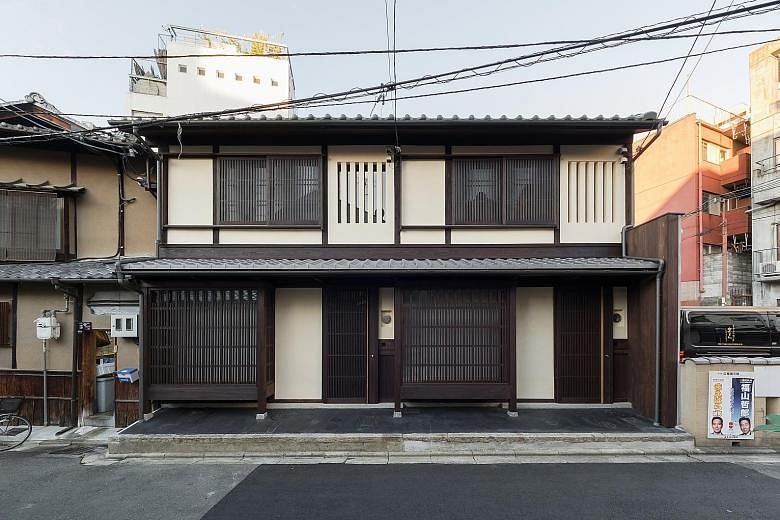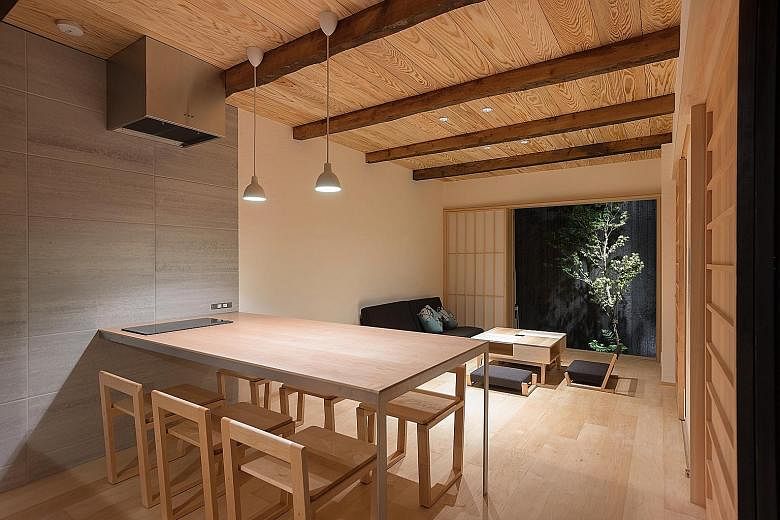If not for three Singaporeans and a Malaysian, two traditional townhouses in Kyoto, Japan, would have been demolished and turned into acarpark.
The two-storey wooden houses, with timber floors, clay partitions and baked tile roofs, have survived the two world wars. They were built more than 100 years ago, likely in the Meiji period (1868-1912).
Thanks to the four men, who pooled together a six-figure sum to buy the 1,000 sq ft plot of land on which the townhouses sit, the houses have remained standing.
Turned into serviced accommodation, the property is now called Shimaya Stays, with the name "Shimaya" inspired by the Japanese words for "Singapore" (Shingaporu) and "Malaysia" (Mareshia).
Its previous owner had lived in one of the houses, running a cafe in the other.
But when he died in 2013, both houses were put up for sale. An interested buyer intended to use the land to expand an adjacent carpark.
When financial services professional Lee Yong Chye, 38, heard about this through a property agent, he teamed up with three friends - public servant Gian Yi-Hsen, 40; healthcare services professional Richard Tan, 58; and Malaysian businessman Benjamin Lim, 40 - and bought the freehold plots.
Mr Gian is based in the United States, Mr Lee and Mr Tan in Singapore and Mr Lim in Malaysia.
Mr Lee says: "We love Japan - its culture, food and oddities. But we were tired of waking up in nondescript hotel rooms on our visits. We wanted to own a home in Japan."
They chose Kyoto because it was among the areas not bombed during World War II.
"The city's architecture has been preserved. To own property in Kyoto, we feel, is to own a piece of heritage and history, something that can be found only in a few Japanese cities."
Buying townhouses was a natural step, he adds.
According to the website of Japan Property Central, a real estate brokerage in Tokyo, there were 50,000 townhouses in 1998. Two per cent are demolished each year.
Mr Lee says: "Many are re-built in the name of progress, but this is sad because it reflects an erosion of heritage."
The townhouses' location in the Higashiyama ward, within walking distance to sites such as the Yasaka Shrine, one of the most famous shrines in Kyoto, and the Kiyomizu-dera Temple, a Unesco World Heritage site, was an added bonus.
It is also a 15-minute walk from 15 Michelin-starred restaurants, such as the one-starred Japanese restaurant Gion Kawakami and the three-starred Kikunoi Honten.
Soon after buying the plots in 2014, the friends started restoring the townhouses.
Mr Lee says: "Because we are not Japanese, we felt having a local home-grown element was essential to the project. So we strove to get people from Kyoto involved in the restoration.
"As much as possible, we wanted them to be made in Kyoto, by Kyoto craftsmen."
To this end, they collaborated with a Japanese architect, specialising in the restoration of Kyoto townhouses, as well as local craftsmen.
The building's original structure and walls were retained, but installed with modern-day finishing and fittings. Even then, the group wanted all the furniture - such as beds and dining tables - to be handmade by Kyoto craftsmen, to ensure authenticity.
Restoration works, which were supervised by the architect and cost another six-figure sum, were completed in November 2015.
The result are two restored townhouses - named BenTen West and BenTen East - each with a built-up area of about 900 sq ft.
Each can accommodate between five and six people and has three rooms - two with tatami mats, one with Western-style beds - as well as a living area, kitchenette and toilets.
From the living area and the bath tub, one can see a small garden outside the house.
Mr Lee says: "I was very impressed with the craftsmen's work. Many worked past midnight and over the weekend in order to complete the project on time and within budget. Their passion for their craft was truly inspiring."
The four friends, who do not have a background in hospitality, stay in the houses when visiting Kyoto. But when they are away, they open the doors to others.
Mr Lee says: "We currently operate on an exclusive invitation-only basis, so people who want to stay at Shimaya are welcome to get in touch with us over e-mail."
Visit www.shimayastays.com for details.
He pitches the property as premium accommodation and to have either of the townhouses - the entire house - for a night costs US$500 (S$709) to US$700.
Business has been swift enough that the four friends have acquired more land and are building six or seven more townhouses, all set to be turned into serviced accommodation by the end of next year.
Mr Lee says: "To us, it is important to create modern and enduring living spaces, but also preserve culture and share our appreciation of Kyoto with all who are interested."



